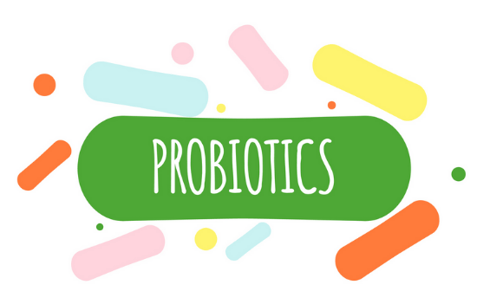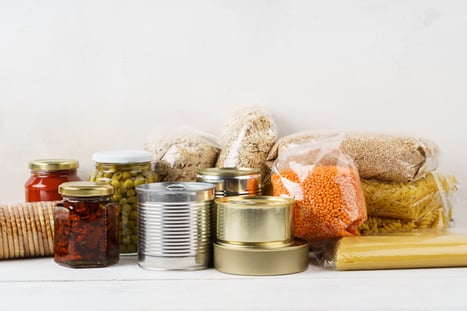 “Take a probiotic; it helps with your gut.” We have all heard it from friends, doctors, and Registered Dietitians. Is it really that simple, though? It is no secret that probiotics really do help with a variety of gastrointestinal (GI) issues. However, did you know that there are specific strains of probiotics that help with specific symptoms, and while one strain may help with one GI symptom, it may not help with another? Not all probiotics are created equal, and not all supplements labeled “probiotic” will yield health benefits.
“Take a probiotic; it helps with your gut.” We have all heard it from friends, doctors, and Registered Dietitians. Is it really that simple, though? It is no secret that probiotics really do help with a variety of gastrointestinal (GI) issues. However, did you know that there are specific strains of probiotics that help with specific symptoms, and while one strain may help with one GI symptom, it may not help with another? Not all probiotics are created equal, and not all supplements labeled “probiotic” will yield health benefits.
What Are Probiotics and Prebiotics?
Probiotics are live microorganisms (tiny living things), mainly bacteria and sometimes yeast, and are intended to have health benefits when ingested. They are similar to the helpful microorganisms naturally found in the gut. Probiotics are found in supplements and fermented foods, such as Greek yogurt with added Lactobacillus and Bifidobacterium, kombucha, tempeh, kefir, and sauerkraut.
Do not confuse these with prebiotics, which are the food source for the “good” bacteria in our GI tract. Prebiotics are “a selectively fermented ingredient that allows specific changes, both in the composition and/or activity in the gastrointestinal microflora that confers benefits upon the host’s well-being and health.” They are carbohydrate compounds, primarily oligosaccharides, that withstand digestion in the GI tract and reach the colon where they then are fermented by the gut microflora, helping the good bacteria to grow. In short, they fall under the categories of soluble fiber and fermentable fiber. This is important, because even if you are taking a probiotic or eating foods rich in probiotics, you may not be receiving the maximum amount of benefits if you are not eating enough prebiotics (soluble and fermentable fiber). Foods rich in prebiotics include green bananas, onion, garlic, asparagus, artichokes, and leeks.
How Do Probiotics Work?
The human GI tract is colonized by many microorganisms, such as bacteria, viruses, fungi, archaea, and protozoa. The totality of these organisms is known as the gut microbiota, microbiome, or intestinal microflora and can affect the health and disease state of a human. Probiotics typically work in the GI tract to alter the intestinal microflora, adding good bacteria to the microbiome. The mechanism of action depends heavily on the species and strains because different species and strains have different effects. Some of the known mechanisms include the following:
- Inhibit the growth of some pathogens (microorganisms causing disease or sickness).
- Help with vitamin synthesis (B vitamins and vitamin K).
- Increase absorption of protein.
- Reinforce the gut barrier, keeping food and other GI contents from leaking into the bloodstream.
- Neutralize toxins.
- Lower the pH in the colon, which could help speed up stool for those who are constipated.
- Replenish good bacteria after taking antibiotics, which may help resolve diarrhea from antibiotics.
Probiotics and Gut Health
The gut microbiota is the center of much current research. Researchers are suggesting that an imbalance in the gut microbiota could lead to several health issues including immune dysfunction, infection, obesity, and GI problems. The imbalance can come from medical conditions, stress, and antibiotic usage (which destroys bad and good bacteria).
Using a probiotic to restore balance has been shown to alleviate symptom persistence in irritable bowel syndrome (IBS) by 21% using both single-strain and multiple-strain supplements, with the mixtures being most effective. Studies also found symptom relief in ulcerative colitis, reduction in acute diarrhea duration and frequency, and lower risk of diarrhea from antibiotic use by 51% or clostridium difficile infection.
A healthy gut with plenty of good bacteria has also been shown to improve the immune system, combat inflammation, and potentially reduce bad cholesterol (total and LDL cholesterol).
Picking Probiotic Supplements
Remember, not all probiotic strains and species are created equal. Trying to figure out exactly what strain, species, and genus of probiotic will work for you and your needs can be tedious, because there are thousands upon thousands of variations. It may take some trial and error to finally find a probiotic that meets your needs.
The good news is that both Lactobacillus and Bifidobacterium are the most studied probiotic genera. There are several studies of strains from these two genera that have produced positive results. Below is a list of conditions with the genus and strain of probiotic that has shown promise in helping with the condition.
- Acute diarrhea: Lactobacillus paracasei or Lactobacillus rhamnosus or Saccharomyces boulardii
- Antibiotic-associated diarrhea: Lactobacillus casei, Lactobacillus bulgaricus, Lactobacillus acidophilus, Lactobacillus rhamnosus
- Overall symptoms of IBS: Bifidobacterium bifidum, Escherichia coli
- Abdominal pain: Bacillus coagulans, Bifidobacterium bifidum, Lactobacillus plantarum
- Bloating/distention: Bifidobacterium animalis, Bifidobacterium bifidum, Lactobacillus reuteri
- Constipation: Bacillus coagulans, Bifidobacterium animalis, Oligofructose (prebiotics)
- Lactose maldigestion: yogurt with Lactobacillus delbruecki susp bulgaricus and Strepococcus thermophilus
- High Cholesterol and LDL: Lactobacillus acidophilus, a mixture of Lactobacillus acidophilus and Bifidobacterium lactis, Lactobacillus plantarum (more research is needed here)
If you are struggling with GI symptoms and considering a probiotic supplement, it is important to talk this over with your Registered Dietitian (RD) and primary care provider. They can help to identify the correct genus, strain, species, and dose you need.
Feed Your Gut
For those healthy individuals, you most likely do not need a probiotic supplement. If you really want to help your gut, follow these tips:
- Eat foods rich in probiotics. When seeking foods with probiotics, the product must have active and live bacterial culture and indicate that on the label. A good rule of thumb is at least 1 billion colony-forming units or 1 billion CFUs, containing the genus Lactobacillus, Bifidobacterium, or Saccharomyces boulardii. Probiotic-rich examples include Greek yogurt, kombucha, tempeh, kefir, and sauerkraut. Be sure to check the label for the specific genus of probiotics(s) in the products, as they will differ. Also note that the starter cultures in Greek yogurt are Streptococcus thermophilus and Lactobacillus bulgaricus, but these are often destroyed by our stomach acid and offer no benefits. Get the Greek yogurt brands that add extra bacteria to the starter cultures (check the label).
- Feed your probiotics with prebiotics to help the probiotics multiply in your microbiome.
- Sleep at least 7–8 hours each night.
- Maintain a healthy weight and body fat percentage.
- Manage stress.
- Balance your diet, keeping it loaded with fruits, veggies, lean proteins, fiber, and whole grains.
As always, reach out to the NIFS Registered Dietitian for nutrition help, including nutrition management of gut-related issues. We are here for you.
This blog was written by Sabrina Goshen, NIFS Registered Dietitian. To learn more about the NIFS bloggers, click here.


 Dietary supplement usage is reaching an all-time high. The
Dietary supplement usage is reaching an all-time high. The  A few years ago, I made it my New Year’s Resolution to completely cut out animal products from my diet. I had played around with a couple variations of diets for a few years in college while competing in a Division 1 rowing program—cutting out all red meat, processed meats, and chicken, and only eating fish. Essentially the only things left were the eggs, milk, and cheese. I had been hesitant because cheese was my absolute favorite thing to add to every meal. I dreamed about doing a cheese and wine tour of Europe one day—I was really in love with cheese.
A few years ago, I made it my New Year’s Resolution to completely cut out animal products from my diet. I had played around with a couple variations of diets for a few years in college while competing in a Division 1 rowing program—cutting out all red meat, processed meats, and chicken, and only eating fish. Essentially the only things left were the eggs, milk, and cheese. I had been hesitant because cheese was my absolute favorite thing to add to every meal. I dreamed about doing a cheese and wine tour of Europe one day—I was really in love with cheese. These past few weeks have been trying times for not only our families and friends, but also for the athletes we engage with on a daily basis throughout the year. In our position we must stay in a lead-by-example mentality. If we let ourselves go during this time, our athletes will notice and do the exact same thing. This is definitely a time of uncertainty and there are a lot of unknowns. Controlling what we can control on a daily basis is what will help not just us personally, but also those around us, to get through and come out of this on top.
These past few weeks have been trying times for not only our families and friends, but also for the athletes we engage with on a daily basis throughout the year. In our position we must stay in a lead-by-example mentality. If we let ourselves go during this time, our athletes will notice and do the exact same thing. This is definitely a time of uncertainty and there are a lot of unknowns. Controlling what we can control on a daily basis is what will help not just us personally, but also those around us, to get through and come out of this on top. When I say “meal prep,” do you picture hours upon hours in the kitchen, a stockpile of containers, and food that you are sick of by week’s end? PAUSE right there! I am here to tell you that meal prep does not have to be that way. It does not have to be too time-consuming or hard, and you don’t have to eat the exact same meal over and over.
When I say “meal prep,” do you picture hours upon hours in the kitchen, a stockpile of containers, and food that you are sick of by week’s end? PAUSE right there! I am here to tell you that meal prep does not have to be that way. It does not have to be too time-consuming or hard, and you don’t have to eat the exact same meal over and over.  Can we just cut out the term “cheat meal” already? This fuels the idea that foods are “good” or “bad,” and, in turn, our food choices then become this reflection of us, as humans, being “good” or “bad.” News flash, you are not “bad” for eating a specific food.
Can we just cut out the term “cheat meal” already? This fuels the idea that foods are “good” or “bad,” and, in turn, our food choices then become this reflection of us, as humans, being “good” or “bad.” News flash, you are not “bad” for eating a specific food. Take these next few weeks or so and use them to your advantage. We know this is an extremely challenging time, and we want to make sure you feel like you are taken care of. Circumstances are tricky right now, so even if you adopt one new technique, consider that a win! Don’t expect yourself to “eat the rainbow” every day, feel like you fall asleep easily at night from a relaxing day working at home in your pajamas, or get in a 10-mile run each morning. While you shelter at home and stay healthy, keep these tips in mind.
Take these next few weeks or so and use them to your advantage. We know this is an extremely challenging time, and we want to make sure you feel like you are taken care of. Circumstances are tricky right now, so even if you adopt one new technique, consider that a win! Don’t expect yourself to “eat the rainbow” every day, feel like you fall asleep easily at night from a relaxing day working at home in your pajamas, or get in a 10-mile run each morning. While you shelter at home and stay healthy, keep these tips in mind..jpg?width=404&name=GettyImages-980276548(1).jpg)
 Ingredients
Ingredients The kids and grandkids are home! With them being home, this means you are having to provide breakfasts and lunches. For those that relied on schools to provide these meals, this can be a stressor added to the day. Maybe your kids received meals for free or at a reduced price. Maybe you are being expected to work from home, all while attempting to help your kids through e-learning and cook them lunch. There are an abundance of reasons as to why this may be tough. You are not alone. We are in this together- as a community. We will get through this.
The kids and grandkids are home! With them being home, this means you are having to provide breakfasts and lunches. For those that relied on schools to provide these meals, this can be a stressor added to the day. Maybe your kids received meals for free or at a reduced price. Maybe you are being expected to work from home, all while attempting to help your kids through e-learning and cook them lunch. There are an abundance of reasons as to why this may be tough. You are not alone. We are in this together- as a community. We will get through this. 1. Stock up on nutritious foods from all food groups.
1. Stock up on nutritious foods from all food groups.